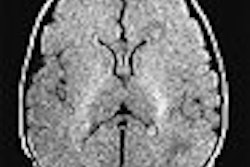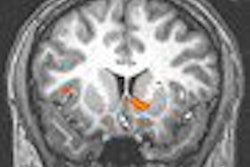After a shaken baby recovers from the immediate trauma that prompted medical intervention, it may be difficult to distinguish those who suffered more significant and long-lasting brain injury in the process. But researchers said an MR spectroscopy (MRS) exam in the acute phase may actually distinguish those children quite accurately, according to a presentation on Tuesday at American Society of Neuroradiology (ASNR) meeting in Seattle.
A new study of 11 shaken babies from the Children's Hospital Medical Center in Cincinnati, OH, found that the four infants with elevated lactate in several regions of the brain -- indicating global ischemic injury -- were the same babies who required ICU admission and had early seizures and abnormal initial neurologic exams.
Conversely, three children with no evidence of lactate on MRS had none of the other early outcome indicators, the researchers found. The findings were presented to ASNR attendees by Dr. Kim Cecil from Children's.
While it may have been clear at presentation that some of the infants were more severely injured than others, a hypoxic-ischemic injury to the brain can only be seen with imaging, noted co-author Dr. Kathi Makaroff, a research instructor of pediatrics at the center.
But the real value of MR spectroscopic confirmation may be in focusing long-term resources on those children who suffered the greatest brain damage up front, Makaroff said.
"If we can show early on that this is a kid who may do poorly, we can concentrate services on those kids and not necessarily have to give (the extra services) to all of them," Makaroff said. Some social-service agencies have only limited long-term resources to tap for shaken babies, who average just four months of age at the time of injury, she added.
The MRS results also give physicians another basis for arguing that weary caregivers should continue to transport children for ongoing physical therapy and other services, even when the infant appears relatively normal.
"You can't turn back the clock with brain injury and make it better, but at least we can work with the kid and give them real intensive therapy," Makaroff said. "Most of the kids are getting the same care in the short term, but we worry that long-term, they may fall through the cracks."
The Cincinnati researchers used proton MRS to bilaterally sample the frontal lobes and parasagittal cortex within the parietal and occipital lobes of 11 patients, six of whom were male.
In addition to the four children with global ischemic injury and the three with no evidence of lactate, there were four children who fell into a middle ground. These children had focal ischemic injury in one region of the brain on MRS; two of them had early seizures and two had abnormal initial neurologic exams as other early indicators of damage.
The Cincinnati group is not the first to identify the correlation between lactate levels and the outcomes for injured patients. In particular, researchers at the Loma Linda University School of Medicine in California have used MRS to examine infants with both inflicted and accidental injuries.
But since shaken babies and other infants who require MR imaging are relatively few in number -- and preferably so -- researchers need to pool their data to validate their conclusions. "We really need to work collaboratively," said Makaroff, "to be able to get the numbers to be able to make a stronger statistical statement."
By Tracie L. ThompsonAuntMinnie.com staff writer
June 10, 2004
Related Reading
MRI delineates complexities of preterm infant brain, April 30, 2004
MR spectroscopy reveals reduced neuronal viability in ADHD kids, March 18, 2003
MRS tops MRI in staging hypoxic injury, August 16, 2002
Findings on diffusion-weighted MRI may point to shaken-baby syndrome, February 27, 2002
Copyright © 2004 AuntMinnie.com



















